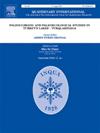Analysis of extreme droughts and floods during 1001–2000 CE in Guangxi, South China, based on historical documents
IF 1.8
3区 地球科学
Q3 GEOGRAPHY, PHYSICAL
引用次数: 0
Abstract
The escalating frequency of extreme droughts and floods amidst global warming poses a significant threat to public health and socio-economic development, making it a critical issue of research in natural disasters. Reconstructing past extreme droughts and floods through historical documents is an essential approach. However, Guangxi, a region in South China, encounters a scarcity of such documents and limited specialized studies on extreme droughts and floods. This study addresses this gap by reconstructing annual drought and flood indices in Guangxi, China, spanning the period from 1001 to 2000 CE, utilizing drought and flood records from historical documents dating back to the Song Dynasty. We determined the yearly sequences of extreme droughts/floods at 88 sites using percentile threshold values and conducted statistical analyses to explore variations in their frequencies and intensities across different periods and regions. Our findings indicate a robust correlation between extreme droughts and stalagmite δ18O-reconstructed precipitation records in South China. Notably, the increase in extreme flood frequency around 1300 CE may be associated with the climatic transition from the Medieval Warm Period to the Little Ice Age, along with weakened Asian summer monsoon intensity. Since 1900 CE, the Central Pacific El Niño has emerged as the dominant driver of El Niño patterns, and concurrent rises in temperatures and greenhouse gas emissions may have significantly contributed to the surge in extreme droughts and floods. These insights enhance our comprehension of historical climate change and provide a scientific basis for anticipating future extreme climate events and guiding disaster preparedness and mitigation strategies.
基于历史文献的2001 - 2000年广西极端旱涝灾害分析
在全球变暖的背景下,极端干旱和洪水日益频繁,对公众健康和社会经济发展构成重大威胁,使其成为自然灾害研究的一个关键问题。通过历史文献重建过去的极端干旱和洪水是必不可少的方法。然而,广西作为中国南方的一个地区,这方面的文献很少,对极端干旱和洪水的专门研究也很有限。本研究利用自宋代以来的历史文献中的干旱和洪水记录,重建了公元1001年至2000年中国广西的年度旱涝指数,从而弥补了这一空白。我们使用百分位阈值确定了88个站点的极端干旱/洪水的年序列,并进行了统计分析,以探索其频率和强度在不同时期和地区的变化。研究结果表明,中国南方极端干旱与石笋δ 18o重建的降水记录具有较强的相关性。值得注意的是,1300年左右极端洪水频率的增加可能与中世纪温暖期到小冰期的气候转变以及亚洲夏季风强度的减弱有关。自公元1900年以来,中太平洋厄尔尼诺Niño已成为厄尔尼诺Niño模式的主要驱动因素,同时气温上升和温室气体排放可能是极端干旱和洪水激增的重要原因。这些见解增强了我们对历史气候变化的理解,并为预测未来极端气候事件和指导备灾和减灾战略提供了科学依据。
本文章由计算机程序翻译,如有差异,请以英文原文为准。
求助全文
约1分钟内获得全文
求助全文
来源期刊

Quaternary International
地学-地球科学综合
CiteScore
5.60
自引率
4.50%
发文量
336
审稿时长
3 months
期刊介绍:
Quaternary International is the official journal of the International Union for Quaternary Research. The objectives are to publish a high quality scientific journal under the auspices of the premier Quaternary association that reflects the interdisciplinary nature of INQUA and records recent advances in Quaternary science that appeal to a wide audience.
This series will encompass all the full spectrum of the physical and natural sciences that are commonly employed in solving Quaternary problems. The policy is to publish peer refereed collected research papers from symposia, workshops and meetings sponsored by INQUA. In addition, other organizations may request publication of their collected works pertaining to the Quaternary.
 求助内容:
求助内容: 应助结果提醒方式:
应助结果提醒方式:


